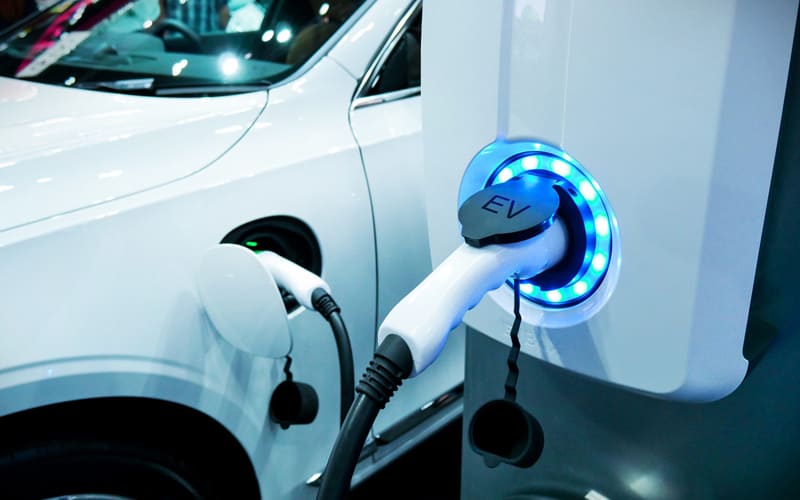
Electric Vehicles: Future of Automotive Industry
Posted on February 21, 2024
Introduction:
The roaring gasoline engines are hastily being replaced by a mild hum of electric motors. Electric vehicles have become a reality, and the industry is swiftly moving from fantasy to plausible disruption. We can be assured that our lives will be less cluttered with the smell of fuel tanks. There won’t be any pollution in cities or outlying areas because these EVs are environmentally friendly. This article outlines the EV’s historical background, tech features that boost it, and both negative and positive aspects.
A Journey Through Time:
Although the idea of EVs can be traced back to the 19th century, it was not until the introduction of the Toyota Prius for public use in 1997 that it marked the beginning of the modern age of EVs. Improvements in battery technology, especially lithium-ion batteries, pushed development further, resulting in long-distance range and good performance at an affordable price. Big manufacturers nowadays, such as Tesla, Volkswagen, and Hyundai, are firmly rolling out their e-models with fascinating features appealing to the specific needs and prices of consumers.
The Green Machine:
The emerging force behind EVs is their positive impact on the environment. They have zero tailpipe emissions, significantly reducing greenhouse gases contributing to climate change. This environmental protection factor increases even more when renewable sources such as solar and wind power EVs. Further, the noise levels of EVs are also lower compared to ICE vehicles in urban and densely populated areas. They help reduce noise pollution, thus ensuring a better living standard.
Charging Up Your Wallet:
Apart from environmental advantages, EVs possess benefits for individual ownership. As fuel prices continue to rise, EV purchases are becoming a better economic option. Even maintenance costs can go down resulting from fewer parts and add to the savings.
In addition, some countries, even India, have various forms of incentives, such as tax opportunities, to boost the sales of EVs. Charging infrastructure development, among other initiatives, is also a way to promote EV implementation. Not only for individuals, if fleet operators like BigBasket and Amazon switched to EVs, they could cut down on their operating costs.
According to Weforum.org, the total cost of ownership for a two-wheeler in New Delhi is Rs.2/km. This can be reduced to Rs.0.5/km when switched to EVs. This can hugely benefit the company and the customer in terms of finance.
A Road with Bumps:
Challenges persist despite the benefits. Some challenges include inadequate charging infrastructure and a high initial cost as compared to gasoline cars. Second, battery manufacturing issues, the evaluation of resource mining, and ethical conduct create high concerns when extracting resources from mines as well.
Nonetheless, these problems are being actively resolved. Battery innovations leap forward at breakneck speed in range and in cost reduction. Governments and private companies invest huge amounts of resources in developing charging structures. Resolving ethical issues in battery production is important for the development of sustainable EVs.
And one of the other challenges is the Indian consumer’s hesitation against new technology. Although the Indian youth population is showing interest in adapting to new technologies, the Indian market is moving at a much slower pace when compared to Europe and the USA. This could be tackled by educating consumers about technology and the long-term it brings.
Collaboration drives Innovation:
EV transformation is a collective effort. Major automotive companies have made heavy R&D investments to unveil new models with heightened sophistication. Furthermore, public and private partnerships between government agencies and EV manufacturing companies are critical when establishing the charging infrastructure, as they can sort out challenges that fall under the regulatory perimeter. Additionally, R&D can speed up innovations in resolving the current issues regarding charging and battery capacity.
A Glimpse into the Future:
The future of EVs looks astonishing. Forecasts show that in 10 years, EVs could consume a share of as much as half of all new automobile sales throughout the world. Adopting EVs is likely to continue at an increased pace with future technology changes, policymakers’ support, and public education. If the expansion of EVs is well conceived and coordinated, it can change the automotive industry and propel a cleaner future in transportation. With more advancements in technology, especially charging stations, they can boost EV sales and thereby turn down pollution.
Conclusion:
The electric revolution has geared off and it is transforming the automobile industry, providing a much-needed solution to address climate change. Although obstacles persist, this environment-economy duality and individual consumer benefits remain undeniable. By continuously backing research, infrastructural development, and responsible procurement procedures, we can embrace EVs to bring us a brighter future as well.
